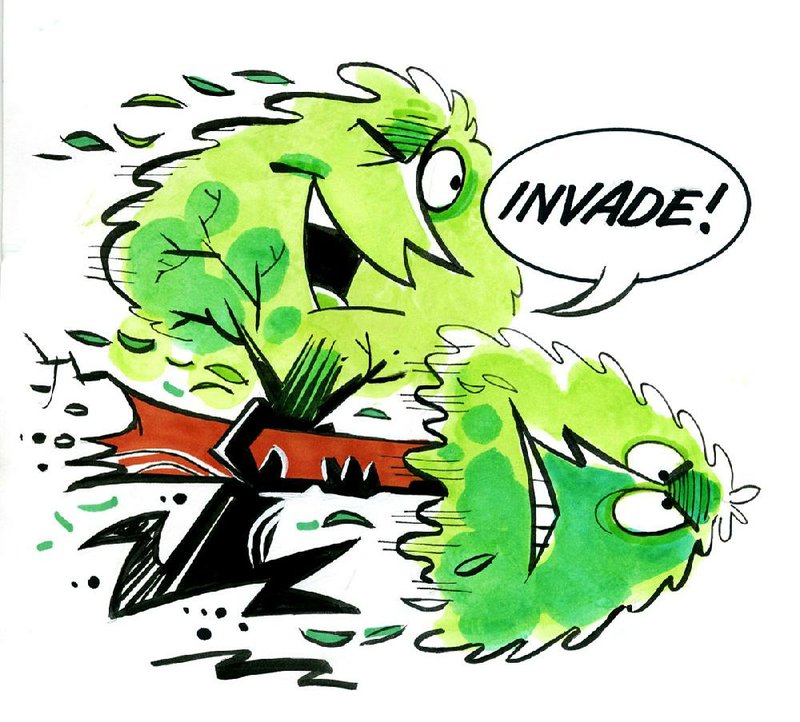Q I enjoy reading your Q&A column in the paper. In a recent response to a person with a dying Bradford pear tree, you suggested the reader not plant a flowering pear next time; but I see it as an opportunity to educate further and more strongly state the problems associated with this and other invasive varieties. Our organization, along with many others, spends thousands of dollars each year and thousands of volunteer hours removing alien invasive species from our natural areas. In particular, Callery pear trees (from the Bradford) constantly threaten a wet prairie that we steward. You have a large following and could do a lot to help educate the public with your responses.
A Thanks for your response. I could not agree with you more about the invasiveness of Bradford or Callery pears in our state. I have a list of the top 10 invasive species of plants in Arkansas, and I rank the Pyrus calleryana (of which many ornamental cultivars are available) as one of the top invasives. Unfortunately, this tree continues to reign in popularity and is commonly sold at all nurseries across the South.
It does have several qualities that make it popular, including beautiful white flowers in the spring and gorgeous fall color, but the resulting fruits are eaten by the birds, dropped, and then seedling Callery pears of all sizes emerge. A large group of these proliferating trees stands beside the highway between Alma and Fort Smith. In the spring, this area is absolutely solid white with Callery pear blooms, and in the fall it's all red from their foliage.
In addition to being invasive, they also are not strong trees, falling apart quite easily with high winds. The other top nine invasives on my list are running bamboo, privet hedge, Japanese honeysuckle, English ivy, kudzu, mimosa, Vinca major, nandina and wisteria. Several of these plants are commonly sold as landscape plants and are widely in use. Other plants have the potential to become invasive if given the right growing conditions.
Q How would you compare the growth rates of "Nellie Stevens" holly and a full-size yaupon holly, like "Pride of Houston"? Would the yaupon have any chance of keeping up, or does it grow a lot more slowly?
A They are both great plants for Arkansas landscapes. The growth rate is similar, but the plants have some big differences. The leaf size of the Nellie Stevens is probably three times that of a yaupon, and the shrub is denser overall. Side by side they would have a different texture and growth habit, with the Nellie Stevens being larger and a bit faster growing.
Q (The reader sent photos of the trunk of a maple tree approximately 20 years old.) Do you know what has damaged it and if it will live? We lost another maple several years ago. I think it did the same thing. This is only on one side of the tree.
A The pictures you sent showed a lot of decayed wood toward the base of the tree, but did not show the overall tree. I would say the damage did not occur recently. As to the lifespan of the tree, a lot will be determined in the spring when the tree leafs out. I have seen trees that were hanging on by a thread of wood and still had a full upper canopy. I would also assess where the tree is in relation to your house or patio. If it has any height, this tree could pose a hazard, since it is at least a third hollow, if not more. Any high wind could cause it to topple, so you may want to cut your losses and plant a new tree.
Q Some of my azaleas look like someone has clipped off the ends of the branches with garden shears. I know no one has done that and assume some animal has. What could be eating on them that would leave what look like clean cuts? Also, what can I do to thwart whatever is eating them? I sprayed around them today with Critter Ridder.
A Sounds like deer to me. They love azaleas. With animal problems, you typically need a variety of things to try to prevent damage, including repellents, scare devices and maybe a good dog.
Janet B. Carson is a horticulture specialist for the University of Arkansas Cooperative Extension Service. Write to her at 2301 S. University Ave., Little Rock, Ark. 72204 or email her at
jcarson@arkansasonline.com
HomeStyle on 01/23/2016
